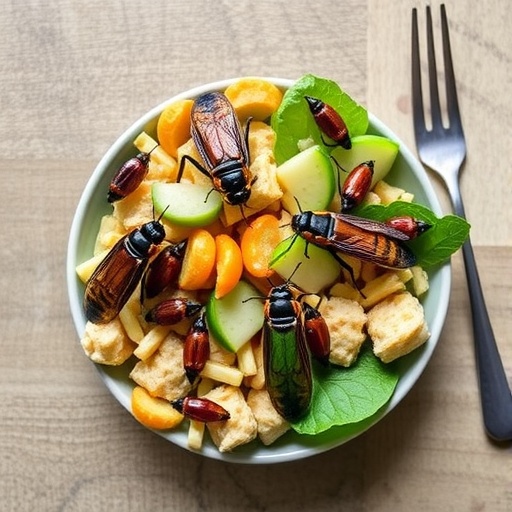In the quest to reduce the environmental burden of industrial animal agriculture, scientists are increasingly turning their attention to alternative protein sources. A revolutionary approach recently detailed in the journal Frontiers in Science explores the potential of hybrid foods—innovative products that blend proteins from diverse origins such as plants, fungi, insects, microbial fermentation, and cultivated meat. This multidisciplinary strategy aims to develop meat substitutes that meet the trifecta of affordability, nutritional value, and palatability, thereby addressing some of the most pressing challenges in sustainable food systems.
The driving force behind this research centers on mitigating the carbon footprint attendant to conventional livestock farming, which remains a significant contributor to climate change. By leveraging the distinct characteristics of each protein source, hybrid foods promise to enhance both resource efficiency and consumer satisfaction. For instance, mycelium, the root-like structure of fungi, imparts a fibrous texture akin to muscle fibers, while cultivated meat leverages cellular agriculture to mimic genuine animal tissue on a microscopic level. Meanwhile, insect protein offers a high-nutrient, ecologically sustainable component, and microbial fermentation can introduce bioactive compounds, pigments, and flavors that enrich the sensory profile of food products.
Despite their promise, alternative protein sources individually face intrinsic limitations. Plant proteins, while economical and scalable, often cannot replicate the complex mouthfeel and flavor profile of meat. Cultivated meat, though structurally akin to animal-derived meat, is still hampered by high production costs and restricted scalability. Mycelium-based products—already featured in some commercial meat analogs—offer a promising texture but require further optimization in flavor and nutritional completeness. Similarly, while insect proteins are environmentally advantageous and nutritious, widespread consumer acceptance in many developed nations remains elusive due to cultural perceptions.
The systematic review conducted by the researchers synthesizes data on various hybrid combinations, analyzing their sensory, nutritional, economic, and environmental attributes. Their findings reveal that hybrid formulations can transcend the limitations inherent in singular protein sources. For example, plant–mycelium hybrids emerge as especially viable in the near term, combining scalability with enhanced texture and nutrition. Meanwhile, plant–cultivated meat hybrids possess long-term potential, as advances in bioprocessing and economies of scale gradually lower production expenses, potentially allowing minor proportions of cultivated meat to markedly elevate product quality.
Consumer acceptance is pivotal in the success of hybrid foods. Early experimental evidence shows that substantial proportions of conventional meat in products like burgers or sausages can be substituted with plant proteins without compromising taste or consumer approval. Furthermore, the introduction of small quantities of cultivated meat or mycelium into plant-based products has been correlated with improvements in flavor, texture, and nutrient density. These findings underscore the complementary synergy achieved through hybrid formulations, making them more than simply the sum of their components.
However, the path toward widespread adoption of hybrid foods is not without obstacles. The complexity of processing cultivated meat and integrating diverse protein sources drives up production costs and introduces technical challenges in scaling operations. Regulatory landscapes remain fragmented or inconsistent, hampering innovation and commercialization. Particularly, insect-derived proteins encounter regulatory ambiguities and significant consumer skepticism outside regions with traditional entomophagy practices. Overcoming ingrained psychological barriers and establishing robust safety frameworks are critical steps toward normalization.
Moreover, many existing plant-based meat alternatives are frequently categorized as ultra-processed foods (UPFs) due to their reliance on numerous additives and intensive processing techniques. This classification is often perceived negatively by health-conscious consumers, partly because observational studies have linked high UPF consumption with adverse health outcomes, albeit without definitive proof of causation. Here, hybrids may offer a crucial advantage by harnessing natural qualities from multiple protein sources, thereby reducing dependence on artificial additives and intensive processing.
In response to these challenges, researchers advocate for concerted efforts among academia, industry stakeholders, and regulatory bodies to catalyze progress. Multidisciplinary research is imperative to optimize protein combinations that not only satisfy nutritional standards and sensory expectations but also align with environmental sustainability and economic feasibility. Scaling up production methods effectively and cost-efficiently remains a central focus, as does gaining consumer trust through transparent communication and rigorous quality control.
Emerging technologies, including artificial intelligence, present additional avenues for innovation. Machine learning algorithms can analyze vast datasets to identify novel protein pairings and optimized processing protocols that maximize the benefits of hybrid foods. Such computational tools have the potential to accelerate product development cycles and tailor solutions to diverse dietary preferences and regional resources.
Importantly, the research highlights the ethical dimension intertwined with protein innovation. Reducing reliance on industrial livestock corresponds with enhanced animal welfare and mitigates risks of zoonotic disease transmission and antimicrobial resistance—factors that pose growing threats to public health. Hybrids that partially or wholly replace animal meat provide a pathway toward more humane and secure food systems without sacrificing sensory pleasure or nutritional adequacy.
The vision put forth by leading scientists like Prof. David L. Kaplan and Prof. David Julian McClements encapsulates a future where sustainable food supply is engineered thoughtfully by integrating biological, technological, and social insights. As Professor Kaplan succinctly put it, hybrid foods “could give us delicious taste and texture without breaking the bank or the planet,” signalling a paradigm shift in how humanity nourishes itself amid environmental constraints.
Ultimately, the successful realization of hybrid protein foods will require navigating complex scientific, regulatory, and cultural landscapes. Nevertheless, the promising synergy of combining multiple protein sources offers a tantalizing opportunity to reinvent the meat substitute market, potentially transforming global food systems to be healthier, more sustainable, and more ethical. This evolving frontier represents a vital convergence of food science, environmental stewardship, and public health innovation that could shape dietary futures worldwide.
Subject of Research: Not applicable
Article Title: Hybrid alternative protein-based foods: designing a healthier and more sustainable food supply
News Publication Date: 30-Sep-2025
Web References: http://dx.doi.org/10.3389/fsci.2025.1599300
Keywords: Food production, Food science, Food policy, Global food security, Foods, Sustainable agriculture, Ethics, Animal rights, Nutrition, Animal cells, Diets, Human health, Climate change mitigation, Climate change, Anthropogenic climate change, Climate change adaptation




